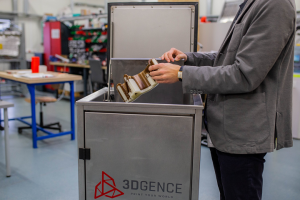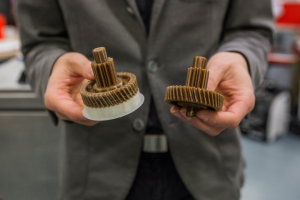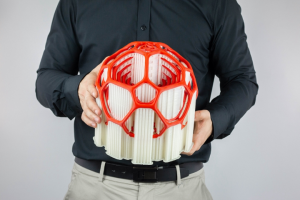Polish 3D printer manufacturer 3DGence, a third wave 3D printing company, has just launched a new product that’s really cool: ESM-10 (Engineering Soluble Material), the first soluble support material for PEEK 3D prints.
“An introduction of the ESM-10 is a milestone not only for 3DGence but also for the entire 3D printing industry,” said Mateusz Sidorowicz, the Marketing Manager at 3DGence. “Soluble support filament for technical materials creates new opportunities, especially for industrial companies. Creating prints with advanced geometry and large dimensions is now easier.”
Before now, PEEK-friendly support materials cost a lot of money, and were pretty difficult to remove from prints. Most people were just using PEEK as a support material for PEEK. Depending on the grade this could cost $600 or more per Kilo and be difficult to remove as well. But ESM-10, just one in a series of advanced engineering filaments that are used to create complex 3D prints with necessary complex supports, uses a heated chamber – above 80°C, to be exact – to ensure the support structure’s stability for models made with both PEEK and ABS materials.
The ESM-10 support material, which can be easily washed out in a prepared water solution, is designed for technical applications and is compatible with the 3DGence INDUSTRY F340 industrial 3D printer.
While ESM-10 is recommended for ABS and PEEK model materials, this is not the case for PLA filament; it’s much better to use soluble materials like PVA or BVOH with the popular plastic.
- INDUSTRY F340
- ABS part with ESM-10 supports
ESM-10 is able to endure, as 3DGence puts it, “the temperature of the working chamber in which it can be printed,” and the material won’t clog up any hotends or recrystallize, since it can be 3D printed at higher temperatures. Because of its unique features, the soluble material can also be used as a support for prints made out of more technical materials where options like BVOH or PVA can’t be used.
In addition to its new ESM-10 support material, 3DGence has also introduced its SDS, short for Support Dissolving System: a circulation tank that was designed specifically for the purposes of dissolving the supports from 3D prints.
“SDS is dedicated to removing support structures from 3D prints made of PEEK or ABS. Its greatest advantage is that it eliminates the need for manually removing supports,” said Filip Turzyński, the Quality Development Manager at 3DGence. “Thanks to this solution we can be sure that the printed model will not be damaged in any way. In the automated rinsing process we can obtain a clean model free of supports, which is fully functional.”
 The SDS machine includes a large, actively heated working chamber, which has a total capacity of 55.2 liters, and also comes with a 36 x 36 x 28 cm basket for 3D prints that allows larger models to be totally immersed in a water solution in order to rinse away the supports. Both the heating system and the device’s insulation ensure that the temperature inside is well-suited to efficiently remove support materials.
The SDS machine includes a large, actively heated working chamber, which has a total capacity of 55.2 liters, and also comes with a 36 x 36 x 28 cm basket for 3D prints that allows larger models to be totally immersed in a water solution in order to rinse away the supports. Both the heating system and the device’s insulation ensure that the temperature inside is well-suited to efficiently remove support materials.
Users need to pour a dedicated chemical solvent into the SDS circulation tank, which will effectively dissolve the ESM-10 support material without causing any damage to the 3D printed model’s material. Because the water system is connected to the water pump, it’s very easy to fill and empty the SDS, and you can safely discharge the combined chemical solution and dissolved ESM-10 material into the sewage system once rinsing is complete.
This once again validates the space increasingly occupied by third wave companies who are going further than just the box. 3DGence is not looking at just the printer they’re looking at the materials, settings and even post-processing equipment to expand the makable. This kind of careful consideration will expand the sum total of the makable and increase what can be made using our technology.
Discuss this news and other 3D printing topics at 3DPrintBoard.com or share your thoughts in the Facebook comments below.
[Images provided by 3DGence]Subscribe to Our Email Newsletter
Stay up-to-date on all the latest news from the 3D printing industry and receive information and offers from third party vendors.
You May Also Like
Further Understanding of 3D Printing Design at ADDITIV Design World
ADDITIV is back once again! This time, the virtual platform for additive manufacturing will be holding the first-ever edition of ADDITIV Design World on May 23rd from 9:00 AM –...
3D Printer Maker EVO-tech Reborn as NEVO3D — Once More With Feeling
EVO-tech was a 3D printing service and original equipment manufacturer established in 2013 and based in Schörfling am Attersee, Austria. The company produced high-quality material extrusion systems featuring linear bearings,...
3D Systems Brings 3D Printed PEEK Cranial Implant to the U.S. with FDA Clearance
For more than 10 years, 3D Systems (NYSE:DDD) has worked hand-in-hand with surgeons to plan over 150,000 patient-specific cases, and develop more than two million instruments and implants from its...
CDFAM Returns to Berlin for Second Annual Symposium
The second CDFAM Computational Design Symposium is scheduled for May 7-8, 2024, in Berlin, and will convene leading experts in computational design across all scales. Building upon the first event...



































